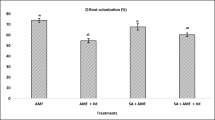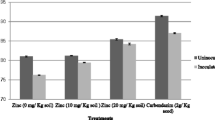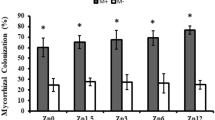Abstract
The use of zinc oxide nanoparticles (ZnO NPs) is part of the search for strategies to achieve food security in a sustainable way. However, its usefulness in crop production has not been sufficiently demonstrated and its consequences on soil microorganisms are still unclear. In this study, the combined effect of ZnO NPs and inoculation with arbuscular mycorrhizal fungi (AMF) on growth, yield, and antioxidant capacity of Capsicum chinense Jacq. was analyzed. Additionally, the effect of ZnO NPs on mycorrhizal colonization and dependency was evaluated. For this purpose, a greenhouse experiment was performed in which 0, 1.2, 12, and 240 mg kg−1 of ZnO NPs were applied to mycorrhized and non-mycorrhized plants. Fresh and dry biomass, fruit yield, and antioxidant capacity were quantified, as well as colonization percentage and mycorrhizal dependency. It was found that the ZnO NPs 240 mg kg−1 dose increased plant fresh aerial biomass and antioxidant capacity, while all ZnO NPs doses increased fruit biomass. On the other hand, the 12 and 240 mg kg−1 doses decreased mycorrhizal dependency, but no ZnO NPs dose affected mycorrhizal colonization. In turn, the inoculation with AMF increased all growth and fruit yield variables, but not the antioxidant capacity of habanero pepper. Besides, an antagonistic effect on fruit biomass was found between the addition of ZnO NPs and the inoculation with AMF. These results demonstrate that the application of ZnO NPs within the dosage range of 1.2 to 240 mg kg−1 enhances the yield of C. chinense without impacting its mycorrhizal interaction.



Similar content being viewed by others
Data availability
No datasets were generated or analyzed during the current study.
References
Sabir S, Arshad M, Chaudhari SK (2014) Zinc oxide nanoparticles for revolutionizing agriculture: synthesis and applications. Sci World J 925494. https://doi.org/10.1155/2014/925494
Shi LE, Li ZH, Zheng W, Zhao YF, ** YF, Tang ZX (2014) Synthesis, antibacterial activity, antibacterial mechanism and food applications of ZnO nanoparticles: a review. Food Addit Contam: Part A 31(2):173–186. https://doi.org/10.1080/19440049.2013.865147
Umar W, Hameed MK, Aziz T, Maqsood MA, Bilal HM, Rasheed N (2021) Synthesis, characterization and application of ZnO nanoparticles for improved growth and Zn biofortification in maize. Arch Agron Soil Sci 67(9):1164–1176. https://doi.org/10.1080/03650340.2020.1782893
Dapkekar A, Deshpande P, Oak MD, Paknikar KM, Rajwade JM (2018) Zinc use efficiency is enhanced in wheat through nanofertilization. Sci Rep 8:6832. https://doi.org/10.1038/s41598-018-25247-5
Slavin YN, Asnis J, Häfeli UO, Bach H (2017) Metal nanoparticles: understanding the mechanisms behind antibacterial activity. J Nanobiotechnology 15(1):1–20. https://doi.org/10.1186/s12951-017-0308-z
Faizan M, Hayat S, Pichtel J (2020) Effects of zinc oxide nanoparticles on crop plants: a perspective analysis. In: Hayat S, Pichtel J, Faizan M, Fariduddin Q (eds) Sustainable agriculture reviews, vol 41. Springer, Cham. https://doi.org/10.1007/978-3-030-33996-8_4
Joshi D, Somkuwar BG, Kharkwal H, Chandra S (2022) Aroma based varieties of Capsicum chinense Jacq., geographical distribution and scope for expansion of the species. J Appl Res Med Aromat Plants 29:100379
Maskey B, Bhattarai R, Bhattarai G, Shrestha NK (2021) Post-harvest quality of fresh akabare chili (Capsicum chinese) as affected by hydrocooling, package modification and storage temperature. Int J Food Prop 24(1):163–173. https://doi.org/10.1080/10942912.2020.1865399
Tucuch Haas CJ, Angulo Castro A, Tucuch Haas JI (2021) Production and quality of habanero pepper (Capsicum chinense Jacq.) with chemical and organic fertilization. Agro Productividad 14(1). https://doi.org/10.32854/agrop.v14i14.1777
García-López JI, Lira-Saldivar RH, Zavala-García F, Olivares-Sáenz E, Niño-Medina G, Ruiz-Torres NA, Méndez-Argüello B, Díaz-Barriga E (2018) Effects of zinc oxide nanoparticles on growth and antioxidant enzymes of Capsicum chinense. Toxicol Environ Chem 100(5–7):560–572. https://doi.org/10.1080/02772248.2018.1550781
García-López JI, Zavala-Garcia F, Olivares-Saénz E, Lira-Saldivar RH, Barriga-Castro ED, Ruiz-Torres NA, Ramos-Cortez E, Vázquez-Alvarado R, Ninõ-Medina G (2018) Zinc Oxide nanoparticles boosts phenolic compounds and antioxidant activity of capsicum annuum l during germination. Agronomy 8(10). https://doi.org/10.3390/agronomy8100215
Nechitailo GS, Bogoslovskaya OA, Ol’khovskaya IP, Glushchenko NN (2018) Influence of Iron, zinc, and copper nanoparticles on some growth indices of pepper plants. Nanotechnologies Russ 13(3–4):161–167. https://doi.org/10.1134/S1995078018020052
Saad H, Abo Almeek MT (2021) Response of sweet pepper (Capsicum animus L.) to different levels of Nano-zinc and poultry manure. Al-Furat Journal of Innovations in Agricultural Sciences 1(1):46–55 https://journals.atu.edu.iq/index.php/afjias/article/view/63
Lv Z, Sun H, Du W, Li R, Mao H, Kopittke PM (2021) Interaction of different-sized ZnO nanoparticles with maize (Zea mays): accumulation, biotransformation and phytotoxicity. Sci Total Environ 796:148927. https://doi.org/10.1016/j.scitotenv.2021.148927
Watson JL, Fang T, Dimkpa CO, Britt DW, McLean JE, Jacobson A, Anderson AJ (2015) The phytotoxicity of ZnO nanoparticles on wheat varies with soil properties. BioMetals 28(1):101–112. https://doi.org/10.1007/s10534-014-9806-8
Chang YN, Zhang M, **a L, Zhang J, **ng G (2012) The toxic effects and mechanisms of CuO and ZnO nanoparticles. Materials 5(12):2850–2871. https://doi.org/10.3390/ma5122850
Song U, Kim J (2020) Zinc oxide nanoparticles: a potential micronutrient fertilizer for horticultural crops with little toxicity. Hortic Environ Biotechnol 61(3):625–631. https://doi.org/10.1007/s13580-020-00244-8
Lin D, **ng B (2007) Phytotoxicity of nanoparticles: inhibition of seed germination and root growth. Environ Pollut 150(2):243–250. https://doi.org/10.1016/j.envpol.2007.01.016
Perea Vélez YS, Carrillo-González R, González-Chávez M (2021) Interaction of metal nanoparticles–plants–microorganisms in agriculture and soil remediation. J Nanopart Res 23:206. https://doi.org/10.1007/s11051-021-05269-3
Jośko I, Dobrzyńska J, Dobrowolski R, Kusiak M, Terpiłowski K (2020) The effect of pH and ageing on the fate of CuO and ZnO nanoparticles in soils. Sci Total Environ 721:137771. https://doi.org/10.1016/j.scitotenv.2020.137771
Takkar PN, Walker CD (1993) The distribution and correction of zinc deficiency. In: Robson AD (ed) Zinc in soils and plants. developments in plant and soil sciences, vol 55. Springer, Dordrecht. https://doi.org/10.1007/978-94-011-0878-2_11
Duhan JS, Kumar R, Kumar N, Kaur P, Nehra K, Duhan S (2017) Nanotechnology: the new perspective in precision agriculture. Biotechnol Rep 15:11–23. https://doi.org/10.1016/j.btre.2017.03.002
Samei M, Sarrafzadeh MH, Faramarzi MA (2019) The impact of morphology and size of zinc oxide nanoparticles on its toxicity to the freshwater microalga, Raphidocelis subcapitata. Environ Sci Pollut Res 26(3):2409–2420. https://doi.org/10.1007/s11356-018-3787-z
Smith SE, Read DJ (2008) Mycorrhizal symbiosis. Academic Press, London
Plenchette C, Fortin JA, Furlan V (1983) Growth responses of several plant species to mycorrhizae in a soil of moderate P-fertility - I. Mycorrhizal dependency under field conditions. Plant Soil 70(2):199–209. https://doi.org/10.1007/BF02374780
Barrios E (2007) Soil biota, ecosystem services and land productivity. Ecol Econ 64(2):269–285. https://doi.org/10.1016/j.ecolecon.2007.03.004
Anderson AJ, McLean JE, Jacobson AR, Britt DW (2017) CuO and ZnO nanoparticles modify Interkingdom cell signaling processes relevant to crop production. J Agric Food Chem 66(26):6513–6524. https://doi.org/10.1021/acs.jafc.7b01302
Miri A, Mahdinejad N, Ebrahimy O, Khatami M, Sarani M (2019) Zinc oxide nanoparticles: biosynthesis, characterization, antifungal and cytotoxic activity. Mater Sci Eng C 104:109981. https://doi.org/10.1016/j.msec.2019.109981
Sirelkhatim A, Mahmud S, Seeni A, Kaus NHM, Ann LC, Bakhori SKM, Hasan H, Mohamad D (2015) Review on zinc oxide nanoparticles: antibacterial activity and toxicity mechanism. Nano-Micro Lett 7(3):219–242. https://doi.org/10.1007/s40820-015-0040-x
Wang F, **g X, Adams CA, Shi Z, Sun Y (2018) Decreased ZnO nanoparticle phytotoxicity to maize by arbuscular mycorrhizal fungus and organic phosphorus. Environ Sci Pollut Res 25(24):23736–23747. https://doi.org/10.1007/s11356-018-2452-x
Wang F, Liu X, Shi Z, Tong R, Adams CA, Shi X (2016) Arbuscular mycorrhizae alleviate negative effects of zinc oxide nanoparticle and zinc accumulation in maize plants - a soil microcosm experiment. Chemosphere 147:88–97. https://doi.org/10.1016/j.chemosphere.2015.12.076
Wang F, Adams CA, Shi Z, Sun Y (2018) Combined effects of ZnO NPs and Cd on sweet sorghum as influenced by an arbuscular mycorrhizal fungus. Chemosphere 209:421–429. https://doi.org/10.1016/j.chemosphere.2018.06.099
Ghasemi Siani N, Fallah S, Pokhrel LR, Rostamnejadi A (2017) Natural amelioration of zinc oxide nanoparticle toxicity in fenugreek (Trigonella foenum-gracum) by arbuscular mycorrhizal (Glomus intraradices) secretion of glomalin. Plant Physiol Biochem 112:227–238. https://doi.org/10.1016/j.plaphy.2017.01.001
Watts-Williams SJ, Turney TW, Patti AF, Cavagnaro TR (2014) Uptake of zinc and phosphorus by plants is affected by zinc fertiliser material and arbuscular mycorrhizas. Plant Soil 376(1):165–175. https://doi.org/10.1007/s11104-013-1967-7
White PJ, Broadley MR (2011) Physiological limits to zinc biofortification of edible crops. Front Plant Sci 2:80. https://doi.org/10.3389/fpls.2011.00080
Brunauer S, Emmett PH, Teller E (1938) Adsorption of gases in multimolecular layers. J Am Chem Soc 60(2):309–319. https://doi.org/10.1021/ja01269a023
Baugh OF, Barrett EP, Joyner LG, Halenda PP (1951) The determination of pore volume and area distributions in porous substances. I. Computations from nitrogen isotherms. J Am Chem Soc 73(1):373–380. https://doi.org/10.1021/ja01145a126
Herrera-Parra E, Hernández-Cuevas L, Cristobal-Alejo J, Parra-Tabla V, Ramos-Zapata J (2021) Native mycorrhizal fungi induce positive and differential effects on initial growth in Capsicum spp. Acta Agrícola y Pecuaria 7(1). https://doi.org/10.30973/aap/2021.7.0071020
Lawrence WJC (1956) Heat sterilization. In: Soil sterilization. MacMillan Co., New York, pp 47–50
Soria M, Trejo A, Tun J, Terán R (2001) Paquete tecnológico para la producción de chile habanero (Capsicum chinense Jacq.). SEP. DGETA. ITA-2.
López-Luna J, Camacho-Martínez MM, Solís-Domínguez FA, González-Chávez MC, Carrillo-González R, Martinez-Vargas S, Mijangos-Ricardez OF, Cuevas-Díaz MC (2018) Toxicity assessment of cobalt ferrite nanoparticles on wheat plants. J Toxic Environ Health A 81(14):604–619. https://doi.org/10.1080/15287394.2018.1469060
Phillips JM, Hayman DS (1970) Improved procedures for clearing roots and staining parasitic and vesicular-arbuscular mycorrhizal fungi for rapid assessment of infection. Trans Br Mycol Soc 55(1):158–IN18. https://doi.org/10.1016/S0007-1536(70)80110-3
McGonigle TP, Miller MH, Evans DG, Fairchild GL, Swan JA (1990) A new method which gives an objective measure of colonization of roots by vesicular—arbuscular mycorrhizal fungi. New Phytol 115(3):495–501. https://doi.org/10.1111/j.1469-8137.1990.tb00476.x
García-López JI, Niño-Medina G, Olivares-Sáenz E, Lira-Saldivar RH, Barriga-Castro ED, Vázquez-Alvarado R, Rodríguez-Salinas PA, Zavala-García F (2019) Foliar application of zinc oxide nanoparticles and zinc sulfate boosts the content of bioactive compounds in habanero peppers. Plants 2019(8):254. https://doi.org/10.3390/plants8080254
Zhang H, Wang R, Chen Z, Cui P, Lu H, Yang Y, Zhang H (2021) The effect of zinc oxide nanoparticles for enhancing rice (Oryza sativa L.) yield and quality. Agriculture 11(12):1247. https://doi.org/10.3390/agriculture11121247
Liu X, Wang F, Shi Z, Tong R, Shi X (2015) Bioavailability of Zn in ZnO nanoparticle-spiked soil and the implications to maize plants. J Nanopart Res 17(4). https://doi.org/10.1007/s11051-015-2989-2
Alloway BJ (2008) Zinc in soils and crop nutrition, 2nd edn. international zinc association & international fertiizer industry association, Belgium, pp 1–54. https://doi.org/10.1002/9780470960707.ch16
García-Gómez C, Obrador A, González D, Babín M, Fernández MD (2018) Comparative study of the phytotoxicity of ZnO nanoparticles and Zn accumulation in nine crops grown in a calcareous soil and an acidic soil. Sci Total Environ 644:770–780. https://doi.org/10.1016/j.scitotenv.2018.06.356
Bundschuh M, Filser J, Lüderwald S, McKee MS, Metreveli G, Schaumann GE, Schulz R, Wagner S (2018) Nanoparticles in the environment: where do we come from, where do we go to? Environ Sci Eur 30:6. https://doi.org/10.1186/s12302-018-0132-6
Saliani M, Jalal R, Goharshadi EK (2016) Mechanism of oxidative stress involved in the toxicity of ZnO nanoparticles against eukaryotic cells. Nanomedicine J 3:1–14. https://doi.org/10.7508/nmj.2016.01.001
Zhao L, Peralta-Videa JR, Hernandez-Viezcas JA, Hong J, Gardea-Torresdey JL (2012) Transport and retention behavior of ZnO nanoparticles in two natural soils: effect of surface coating and soil composition. Journal of Nano Research 17:229–242. https://doi.org/10.4028/www.scientific.net/JNanoR.17.229
Uresti-Porras JG, Cabrera-De-La Fuente M, Benavides-Mendoza A, Sandoval-Rangel A, Zermeño-Gonzalez A, Cabrera RI, Ortega-Ortíz H (2021) Foliar application of zinc oxide nanoparticles and grafting improves the bell pepper (Capsicum annuum L.) productivity grown in NFT system. Notulae Botanicae Horti Agrobotanici Cluj-Napoca 49(2):1–15. https://doi.org/10.15835/nbha49212327
Hong J, Wang C, Wagner DC, Gardea-Torresdey JL, He F, Rico CM (2021) Foliar application of nanoparticles: mechanisms of absorption, transfer, and multiple impacts. Environ Sci: Nano 8(5):1196–1210
Surendirakumar K, Pandey RR, Muthukumar T (2019) Influence of indigenous arbuscular mycorrhizal fungus and bacterial bioinoculants on growth and yield of Capsicum chinense cultivated in non-sterilized soil. J Agric Sci 157(1):31–44. https://doi.org/10.1017/S0021859619000261
Thilagar G, Bagyaraj DJ (2015) Influence of different arbuscular mycorrhizal fungi on growth and yield of chilly. In: Proceedings of the national academy of sciences, India section B: biological sciences, vol 85, pp 71–75. https://doi.org/10.1007/s40011-013-0262-y
Franczuk J, Tartanus M, Rosa R, Zaniewicz-Bajkowska A, Dębski H, Andrejiová A, Dydiv A (2023) The effect of mycorrhiza fungi and various mineral fertilizer levels on the growth, yield, and nutritional value of sweet pepper (Capsicum annuum L.). Agriculture 13(4):857. https://doi.org/10.3390/agriculture13040857
Eichholtzer J, Ballina-Gómez HS, Gómez-Tec K, Medina-Dzul K (2021) Arbuscular mycorrhizal fungi influence whitefly abundance by modifying habanero pepper tolerance to herbivory. Arthropod Plant Interact 15(6):861–874. https://doi.org/10.1007/s11829-021-09868-8
Pereira JAP, Vieira IJC, Freitas MSM, Prins CL, Martins MA, Rodrigues R (2016) Effects of arbuscular mycorrhizal fungi on Capsicum spp. J Agric Sci 154(5):828–849. https://doi.org/10.1017/S0021859615000714
Slavin YN, Bach H (2022) Mechanisms of antifungal properties of metal nanoparticles. Nanomaterials 12(24):4470. https://doi.org/10.3390/nano12244470
Lv J, Zhang S, Luo L, Zhang J, Yang K, Christie P (2015) Accumulation, speciation and uptake pathway of ZnO nanoparticles in maize. Environ Sci: Nano 2(1):68–77. https://doi.org/10.1039/C4EN00064A
Wang F, **g X, Adams CA, Shi Z, Sun Y (2018) Decreased ZnO nanoparticle phytotoxicity to maize by arbuscular mycorrhizal fungus and organic phosphorus. Environ Sci Pollut Res 25:23736–23747. https://doi.org/10.1007/s11356-018-2452-x
Wijayawardene NN, Hyde KD, Al-Ani LKT, Tedersoo L, Haelewaters D, Rajeshkumar KC, Zhao RL, Aptroot A, Leontyev DV, Saxena RK, Tokarev YS, Dai DQ, Letcher PM, Stephenson SL, Ertz D, Lumbsch HT, Kukwa M, Issi IV, Madrid H, … Castañeda-Ruiz RF (2020) Outline of Fungi and fungus-like taxa. Mycosphere Online: Journal of Fungal Biology 11(1):1060–1456
Mikkelsen BL, Rosendahl S, Jakobsen I (2008) Underground resource allocation between individual networks of mycorrhizal fungi. New Phytol 180(4):890–898. https://doi.org/10.1111/j.1469-8137.2008.02623.x
Smith SE, Smith FA (2011) Roles of arbuscular mycorrhizas in plant nutrition and growth: new paradigms from cellular to ecosystem scales. Annu Rev Plant Biol 62:227–250. https://doi.org/10.1146/annurev-arplant-042110-103846
Ge Y, Schimel JP, Holden PA (2011) Evidence for negative effects of TiO2 and ZnO nanoparticles on soil bacterial communities. Environ Sci Technol 45(4):1659–1664. https://doi.org/10.1021/es103040t
Liu Y, Li Y, Pan B, Zhang X, Zhang H, Steinberg CE, Qiu H, Vijver MG, Peijnenburg WJGM (2021) Application of low dosage of copper oxide and zinc oxide nanoparticles boosts bacterial and fungal communities in soil. Sci Total Environ 757:143807. https://doi.org/10.1016/j.scitotenv.2020.143807
Cao J, Feng Y, Lin X, Wang J (2020) A beneficial role of arbuscular mycorrhizal fungi in influencing the effects of silver nanoparticles on plant-microbe systems in a soil matrix. Environ Sci Pollut Res 27:11782–11796. https://doi.org/10.1007/s11356-020-07781-w
Cao J, Feng Y, Lin X, Wang J (2016) Arbuscular mycorrhizal fungi alleviate the negative effects of iron oxide nanoparticles on bacterial community in rhizospheric soils. Front Environ Sci 4:10. https://doi.org/10.3389/fenvs.2016.00010
Faizan M, Faraz A, Yusuf M, Khan ST, Hayat S (2018) Zinc oxide nanoparticle-mediated changes in photosynthetic efficiency and antioxidant system of tomato plants. Photosynthetica 56:678–686
Faizan M, Bhat JA, Chen C, Alyemeni MN, Wijaya L, Ahmad P, Yu F (2021) Zinc oxide nanoparticles (ZnO-NPs) induce salt tolerance by improving the antioxidant system and photosynthetic machinery in tomato. Plant Physiol Biochem 161:122–130. https://doi.org/10.1016/j.plaphy.2021.02.002
Kumar V, Lakkaboyana SK, Sharma N, Abdelaal AS, Maitra SS, Pant D (2019) Engineered nanomaterials uptake, bioaccumulation and toxicity mechanisms in plants. Comprehensive analytical chemistry. Elsevier, pp 111–131. https://doi.org/10.1016/bs.coac.2019.09.005
Suman TY, Radhika Rajasree SR, Kirubagaran R (2015) Evaluation of zinc oxide nanoparticles toxicity on marine algae chlorella vulgaris through flow cytometric, cytotoxicity and oxidative stress analysis. Ecotoxicol Environ Saf 113:23–30. https://doi.org/10.1016/j.ecoenv.2014.11.015
Luo J, Yan Q, Yang G, Wang Y (2022) Impact of the arbuscular mycorrhizal fungus Funneliformis mosseae on the physiological and Defence responses of Canna indica to copper oxide nanoparticles stress. Journal of Fungi 8(5). https://doi.org/10.3390/jof8050513
Ban Y, **ao Z, Wu C, Lv Y, Meng F, Wang J, Xu Z (2021) The positive effects of inoculation using arbuscular mycorrhizal fungi and/or dark septate endophytes on the purification efficiency of CuO-nanoparticles-polluted wastewater in constructed wetland. J Hazard Mater:416. https://doi.org/10.1016/j.jhazmat.2021.126095
Azcón R, del Perálvarez MC, Biró B, Roldán A, Ruíz-Lozano JM (2009) Antioxidant activities and metal acquisition in mycorrhizal plants growing in a heavy-metal multicontaminated soil amended with treated lignocellulosic agrowaste. Appl Soil Ecol 41(2):168–177. https://doi.org/10.1016/j.apsoil.2008.10.008
Ferrol N, Tamayo E, Vargas P (2016) The heavy metal paradox in arbuscular mycorrhizas: from mechanisms to biotechnological applications. J Exp Bot 67(22):6253–6565. https://doi.org/10.1093/jxb/erw403
Acknowledgements
We thank Ph.D. María del Carmen González-Chávez and Ph.D. Héctor Estrada-Medina for the discussion of ideas, as well as C.A.B. Concepción Capetillo Leal, MSc. Ofelia Beltrán Paz, and MSc. Gerardo Martínez Jardines for their assistance with laboratory work. The Consejo Nacional de Humanidades, Ciencias y Tecnologías (CONAHCyT) funded the Ph.D. scholarship of Uriel Solís-Rodríguez.
Author information
Authors and Affiliations
Contributions
José A. Ramos-Zapata and Elizabeth Herrera-Parra contributed to conceptualization, funding, project administration, resources, methodology, writing—original draft, and writing—review and editing. Uriel Solís-Rodríguez contributed to conceptualization, methodology, writing—original draft, and writing—review and editing. Bruno Chávez-Vergara, Rudy Trejo-Tzab, and Daniel Rosas-Sánchez contributed to resources, methodology, and writing—review and editing.
Corresponding author
Ethics declarations
Competing interests
The authors declare no competing interests.
Additional information
Publisher's Note
Springer Nature remains neutral with regard to jurisdictional claims in published maps and institutional affiliations.
Elizabeth Herrera-Parra and José A. Ramos-Zapata share joint senior authorship.
Supplementary Information
Below is the link to the electronic supplementary material.
Rights and permissions
Springer Nature or its licensor (e.g. a society or other partner) holds exclusive rights to this article under a publishing agreement with the author(s) or other rightsholder(s); author self-archiving of the accepted manuscript version of this article is solely governed by the terms of such publishing agreement and applicable law.
About this article
Cite this article
Solís-Rodríguez, U., Chávez-Vergara, B., Trejo-Tzab, R. et al. Effect of zinc oxide nanoparticles and inoculation with arbuscular mycorrhizal fungi on growth, yield, and antioxidant capacity of Capsicum chinense Jacq. (Habanero pepper). J Nanopart Res 26, 139 (2024). https://doi.org/10.1007/s11051-024-06049-5
Received:
Accepted:
Published:
DOI: https://doi.org/10.1007/s11051-024-06049-5




